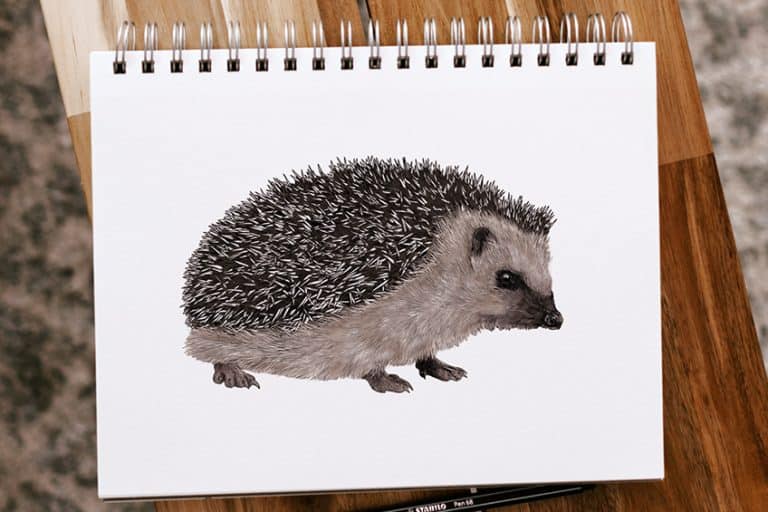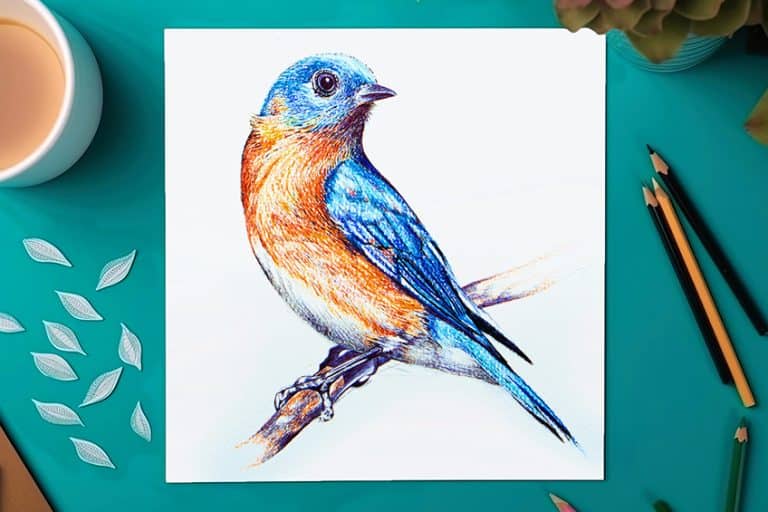How to Draw a Flamingo – Fun Flamingo Illustration Tutorial
Have you ever wanted to draw a flamingo but simply do not know where to start? If so, then you have come to the right place. In this flamingo illustration tutorial, we break this complex bird down into easy-to-follow steps. By gradually building up the proportions, we end up with an easy-to-draw flamingo that is very realistic too. If you are ready to learn how to draw a flamingo, gather your drawing supplies and let us begin!
Easy to Draw Flamingo Tutorial
Flamingos can be quite tricky to draw because they have very unique proportions. In order to ensure these proportions are correct, we build up the final shape using smaller and simpler base shapes. You can see the steps of the tutorial in the collage below. We begin with a simple oval, and then begin to build up the neck shape. After this, we start to add some more detailed flamingo sketch details, before we begin to add color. We use color not only to bring the flamingo illustration to life but also to add more depth and dimension.

This flamingo drawing tutorial is compatible with almost every medium that you choose. If you are a digital artist, then you can easily adapt the instructions to suit a drawing tablet. We suggest that you create the initial construction outline on a separate layer that can be easily erased later. For physical mediums like paint or coloring pencils, we suggest using a very light pencil for these outlines.
Once you have your supplies ready and you have somewhere nice and comfortable to sit, we can begin learning how to draw a flamingo.
Step 1: Shape the Main Body
We begin this flamingo illustration by creating the basic shape of the flamingo’s body. This is a simple oval shape that is sloped with the left side being slightly higher. Find the central point of your drawing area, and place this oval slightly above the center.
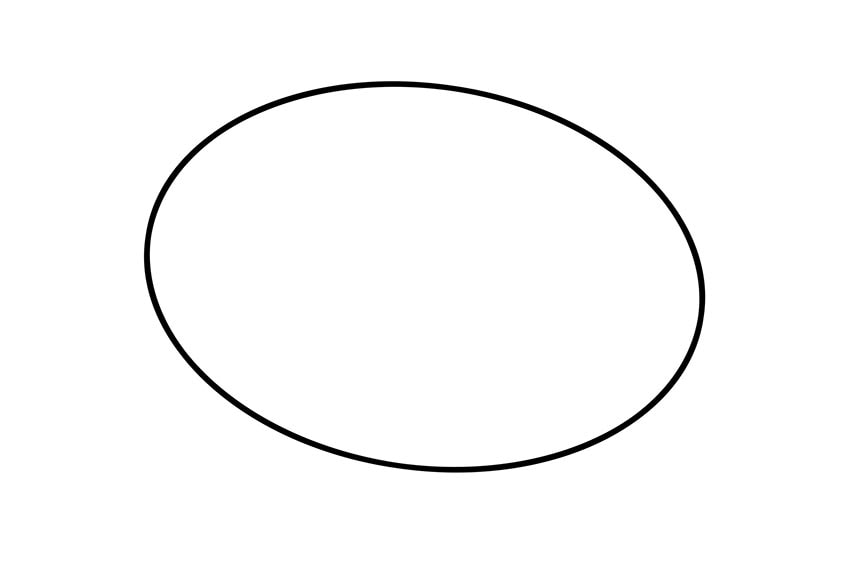
Step 2: Shape the Flamingo Neck
Now that we have the main body of our flamingo sketch in place, we can use it to construct the basic shape of the flamingo’s neck. Begin on the left side of the body, just below it. Draw a long curving line that swoops to the left and up in an elongated “S” shape. You can then complete the neck shape by creating the other line of the neck, beginning just below the left point of the body oval.
This line should end slightly higher than the initial line.

Step 3: Add Feather Details to the Flamingo Tail
We are now going to add some more detail to the body of our flamingo illustration. Using the main body oval as the base shape, draw a large curving wing that is a little less smooth. This wing should end with some slightly jagged feathers that flow downwards. You can also add some feather details to the bottom of the body oval, creating a more realistic shape.
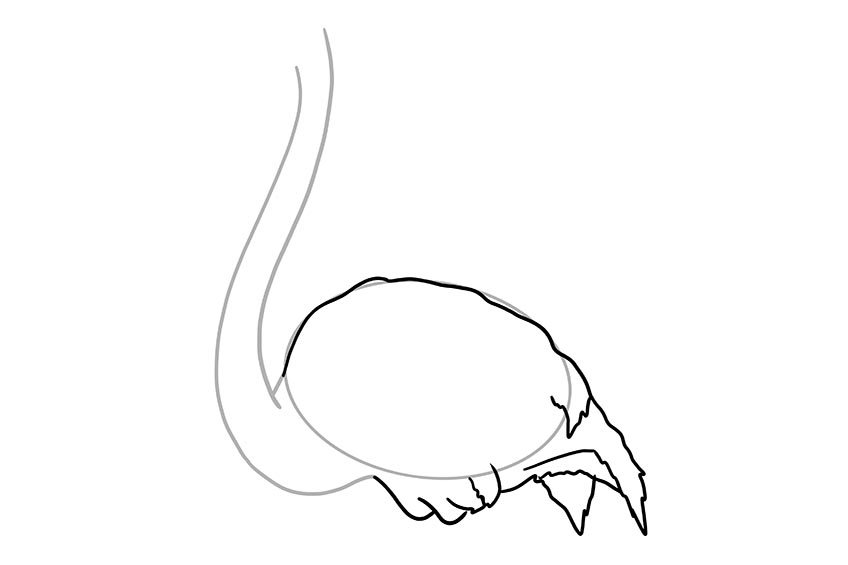
Step 4: Finishing the Flamingo Sketch Outline
In this step, we are going to create the final outline of our flamingo illustration. We will do this by drawing the legs and the head, as well as adding some feather texture to the body. Begin with the small rounded head on the top of the neck. You can also draw the large downward-curving beak of the flamingo. Now that you have the shape, you can draw the face detail, including a small round eye and a fine line within the beak. As we move down the body of your flamingo sketch, we can add some feather detail to the main body using a combination of short and long lines. Finally, we will draw the two long noodle-like legs. Flamingos have knees that bend the opposite way to ours, so the legs should first extend slightly backward and then slightly forwards.
To complete your flamingo legs, create webbed feet on the bottom.

Step 5: Apply A Base Color Coat
Now that we have our basic flamingo sketch outlined, we can begin to bring it to life with color. With a regular paintbrush and some light pink paint, evenly coat the entirety of your flamingo illustration.
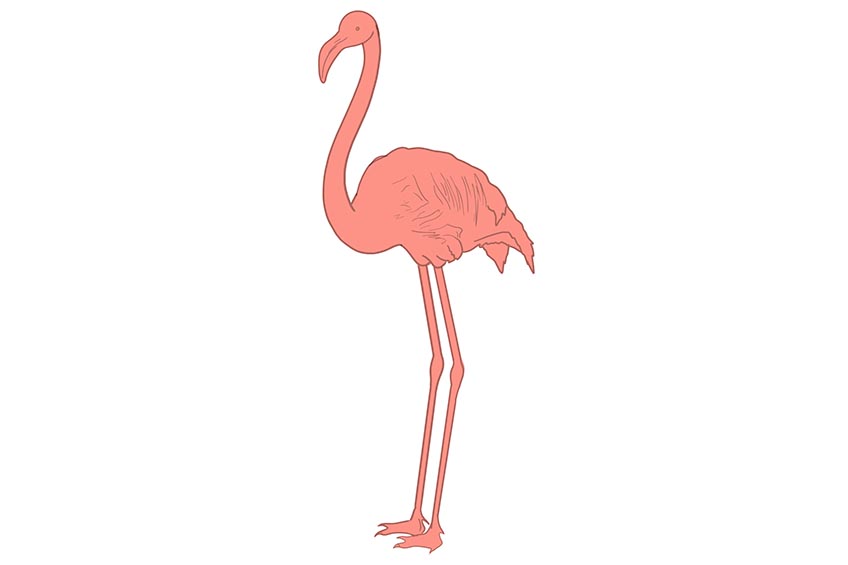
Step 6: Begin Adding the Definition
With our base color now in place, we are going to use a darker shade to add a little three-dimensionality. Begin with a small soft blending brush and either a dark orange or a red shade of paint. Apply a soft contouring layer on the top and bottom areas of the neck including the head and beak. You can then apply a soft touch of contouring between the top feathers and the wing layer.
Finally, with the same soft brush and some grey paint, add a little contouring to the edges of the webbed feet.
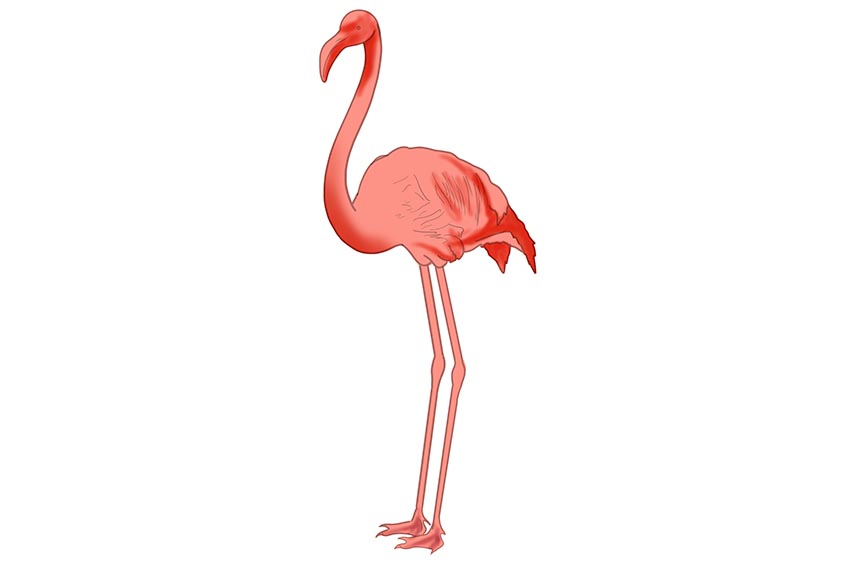
Step 7: Add Feature Texture
This is quite a big step, involving many different forms of texture creation. We will begin with a small blending brush and some black paint, using these to define the separating line of the beak. You can also color the bottom curve of the beak. You can also add some definition to the forehead of the flamingo’s head with some soft shading. Moving on to the neck, use a sharp detailing brush to create spots of dark orange, dark pink, and brown. At the base of the neck, use these colors and some white to create speckles that transition onto the body.
You can then begin to add some long smooth curving brush strokes that flow onto the body.
Repeat this process with a blending brush, creating a variety of different patterns and textures in the feathers. White should be the most prominent color here. On the rear of your flamingo tail, use a darker shade of orange to fill these feathers. Finally, use a small blending brush and some light peach paint to add shading below the main body and along the legs. Repeat this process once more using light purple and a darker shade of purple on the lower legs.
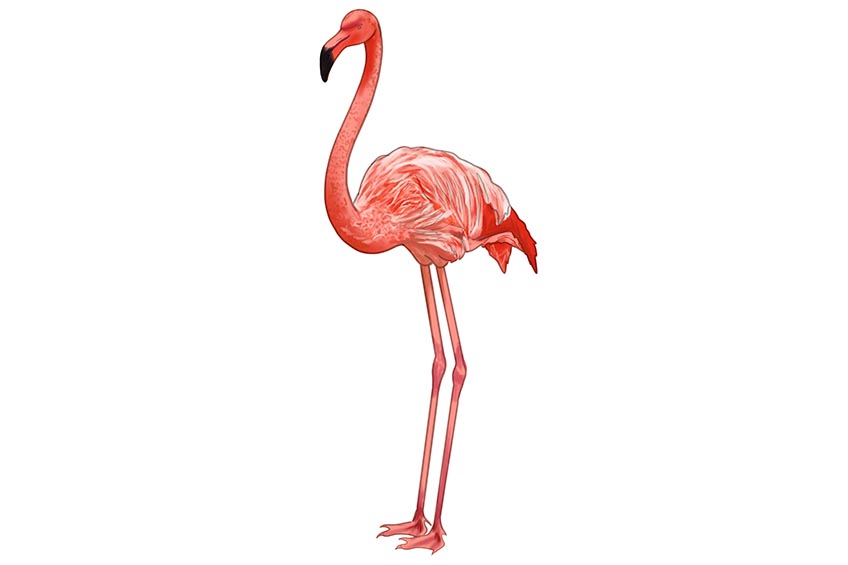
Step 8: Create Fine Detail on the Face
Begin with a small blending brush and some light pink paint, softly blending color to the edge of the face and beak. Repeat this again with white paint and use a clean blending brush to smooth these colors together. Refine the eye using a small brush and some grey paint to add a slight contour around it. Next, with a small detail brush and a combination of white and light pink paint, add a layer of fine dots and spots from the head, down the neck, and onto the body. Apply a second layer of short brush strokes to add depth to the feathers. Complete the step with a small blending brush and light grey paint, creating shading on the side wing.
Finally, smooth all of these colors together with a clean blending brush.
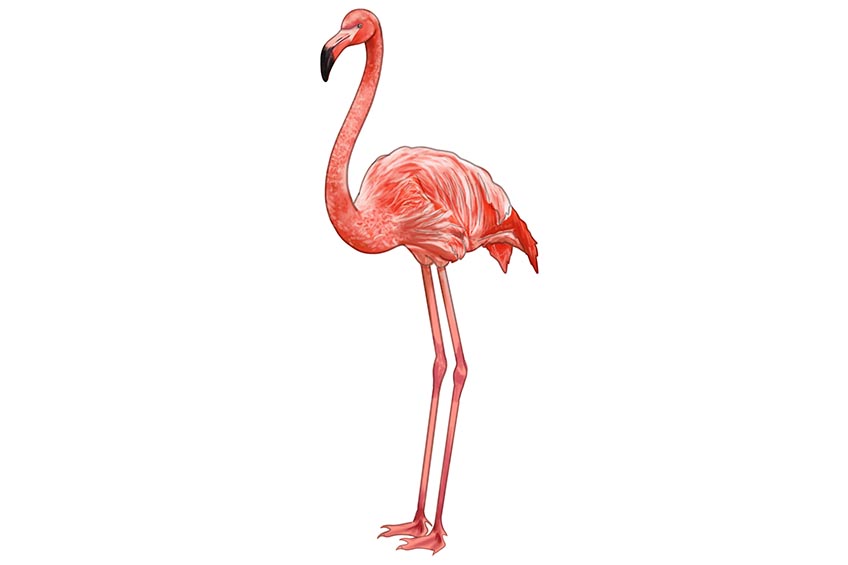
Step 9: Create Texture in the Legs of Your Flamingo Sketch
Let us now define the texture on the legs of your flamingo drawing. Start with a sharp detail brush and some white and light pink paint, creating small dots and spots along both legs. Next, use a small blending brush to add a soft white highlight along the webbed feet. Fill the claw tips with some grey paint.
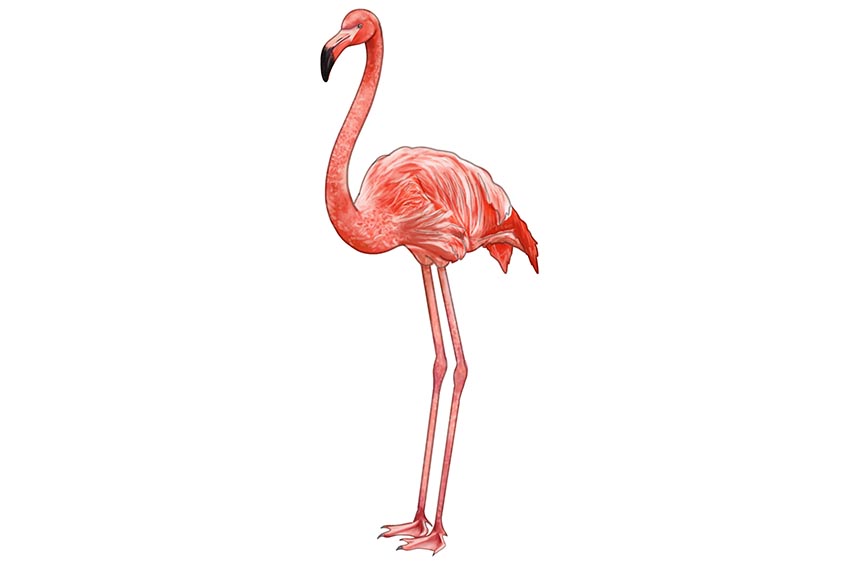
Step 10: Create a Ground Shadow
To highlight the realism of our easy-to-draw flamingo, we are going to add a ground shadow. This will create a more three-dimensional effect. Use some dark grey paint and a small blending brush to create a shadow right around the feet. Gently blend this shadow out, creating a realistic fade.
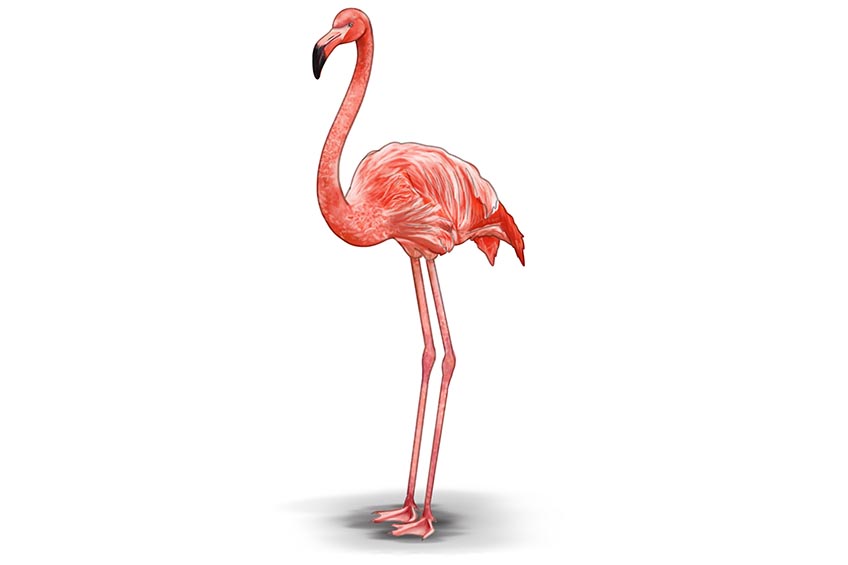
Step 11: Finish Your Flamingo Illustration
To complete our easy-to-draw flamingo sketch, we are going to remove the harsh outlines. For digital artists, you can simply delete the outline layer. For physical mediums, use a fine brush and the corresponding colors to trace over the outline. You can also trace over the inner texture lines, creating a final seamless result. You will now have a realistic flamingo sketch.

We really hope that you have enjoyed learning how to draw a flamingo. Our easy-to-draw flamingo is designed for artists of any level, building up this complex shape in very easy steps. If you are pleased with your realistic flamingo illustration, we hope you will check out some of our other drawing tutorials as you travel along your own road of artistic learning.
View our Flamingo Drawing web story here.
Frequently Asked Questions
How to Draw a Flamingo with Realistic Proportions?
The key to creating realistic proportions in any drawing lies in using basic shapes to gradually build up the final flamingo sketch. As the flamingo has quite unique proportions, this process of construction is even more important. We begin by using ovals and simple “S” shaped curves, before adding details and colors.
What Colors do You Need for a Flamingo Drawing?
Flamingos are known for their bright pink color, but you will need some additional shades for contouring and dimensions. In addition to a light pink shade, you will also need dark orange, red, white, purple, brown, and grey.
Matthew Matthysen is an educated multidisciplinary artist and illustrator. He successfully completed his art degree at the University of Witwatersrand in South Africa, majoring in art history and contemporary drawing. The focus of his thesis was to explore the philosophical implications of the macro and micro-universe on the human experience. Matthew uses diverse media, such as written and hands-on components, to explore various approaches that are on the border between philosophy and science.
Matthew organized various exhibitions before and during his years as a student and is still passionate about doing so today. He currently works as a freelance artist and writer in various fields. He also has a permanent position at a renowned online gallery (ArtGazette) where he produces various works on commission. As a freelance artist, he creates several series and successfully sells them to galleries and collectors. He loves to use his work and skills in various fields of interest.
Matthew has been creating drawing and painting tutorials since the relaunch in 2020. Through his involvement with artincontext.org, he has been able to deepen his knowledge of various painting mediums. For example, watercolor techniques, calligraphy and lately digital drawing, which is becoming more and more popular.
Learn more about Matthew Matthysen and the Art in Context Team.
Cite this Article
Matthew, Matthysen, “How to Draw a Flamingo – Fun Flamingo Illustration Tutorial.” Art in Context. December 2, 2022. URL: https://artincontext.org/how-to-draw-a-flamingo/
Matthysen, M. (2022, 2 December). How to Draw a Flamingo – Fun Flamingo Illustration Tutorial. Art in Context. https://artincontext.org/how-to-draw-a-flamingo/
Matthysen, Matthew. “How to Draw a Flamingo – Fun Flamingo Illustration Tutorial.” Art in Context, December 2, 2022. https://artincontext.org/how-to-draw-a-flamingo/.





